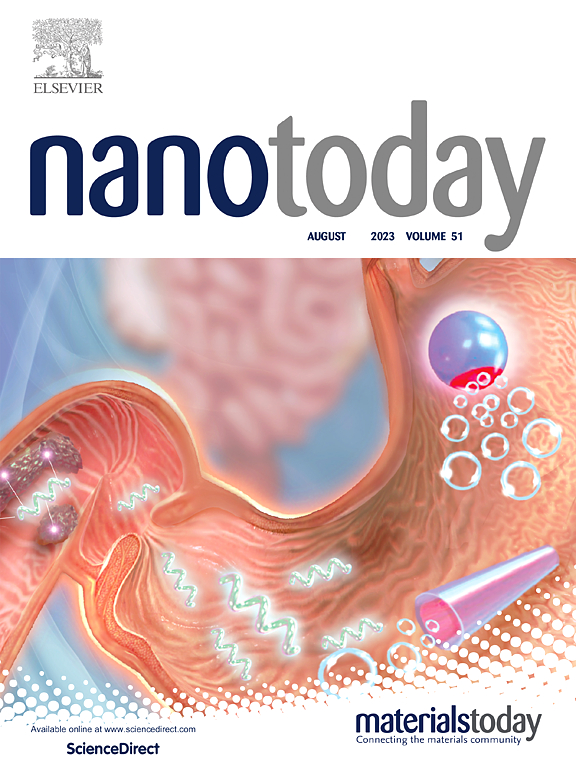利用半导体聚合物纳米颗粒和CuRu纳米酶构建高对比度余辉纳米探针,用于手术导航
IF 10.9
1区 材料科学
Q1 CHEMISTRY, MULTIDISCIPLINARY
引用次数: 0
摘要
精确的肿瘤边界实时成像是手术中有效彻底清除肿瘤残留,防止肿瘤复发的关键。有机余辉发光探针以其高信号背景比(SBR)而闻名,在体内成像方面尤其有前景。然而,目前的余辉成像系统在手术导航方面仍然存在局限性:“始终在线”的探针在肿瘤区域和周围正常组织之间的对比度较差,并且缺乏完全切除肿瘤所需的持久成像能力。在这项工作中,我们通过将半导体聚合物2-甲氧基-5-(2-乙基己氧基)-1,4-苯基乙烯(MEHPPV)与CuRu纳米酶结合,开发了一种新的肿瘤微环境激活的余辉纳米探针,称为FMCR,用于增强活体余辉成像。FMCR的CuRu纳米酶组分表现出强大的过氧化氢酶样活性,持续催化肿瘤微环境中过表达的过氧化氢(H2O2)转化为氧(O2),明显增加了好氧余辉信号。更重要的是,该CuRu纳米酶能够长期持续稳定地催化内源性H2O2产生O2,大大延长了余辉成像的衰减时间。体内实验表明,FMCR促进了活体小鼠皮下移植4T1肿瘤的成像,SBR达到了惊人的20.18。此外,在FMCR的余辉成像引导下,手术有效地切除了腹膜内肿瘤结节,包括直径小于2-4.5 mm的肿瘤结节,这表明了FMCR在精确手术导航方面的巨大潜力。本文章由计算机程序翻译,如有差异,请以英文原文为准。
Building high-contrast afterglow nanoprobe using semiconducting polymer nanoparticles and CuRu nanozyme for prolonged surgical navigation
Precise real-time imaging of tumor boundary is critical for effectively and thoroughly eliminating tumor residuals during surgery to prevent recurrence. Organic afterglow luminescent probes, well known for their high signal-to-background ratio (SBR), are particularly promising for imaging in vivo. However, current afterglow imaging systems still face limitations in surgical navigation: "always-on" probes offer poor contrast between the tumor area and surrounding normal tissues, and lack the enduring imaging capability needed for complete tumor excision. In this work, we developed a novel tumor microenvironment-activated afterglow nanoprobe, denoted as FMCR, by integrating the semiconducting polymer 2-methoxy-5-(2-ethylhexyloxy)-1,4-phenylenevinylene (MEHPPV) with CuRu nanozyme for enhanced intravital afterglow imaging. The CuRu nanozyme component of FMCR exhibits robust catalase-like activity, continuously catalyzing the conversion of overexpressed hydrogen peroxide (H2O2) present in the tumor microenvironment to oxygen (O2), which increased the aerobic afterglow signal distinctly. More importantly, this CuRu nanozyme could sustainably and stably produce O2 by catalyzing endogenous H2O2 over the long term, greatly prolonging the decay time of afterglow imaging. In vivo experiments revealed that FMCR facilitated the imaging of subcutaneously xenografted 4T1 tumors in living mice, with a remarkable SBR of 20.18. Furthermore, guided by afterglow imaging of FMCR, surgery was performed to effectively remove intraperitoneal tumor nodules, including those as smaller as 2–4.5 mm in diameter, which demonstrated the immense potential of FMCR for precise surgical navigation.
求助全文
通过发布文献求助,成功后即可免费获取论文全文。
去求助
来源期刊

Nano Today
工程技术-材料科学:综合
CiteScore
21.50
自引率
3.40%
发文量
305
审稿时长
40 days
期刊介绍:
Nano Today is a journal dedicated to publishing influential and innovative work in the field of nanoscience and technology. It covers a wide range of subject areas including biomaterials, materials chemistry, materials science, chemistry, bioengineering, biochemistry, genetics and molecular biology, engineering, and nanotechnology. The journal considers articles that inform readers about the latest research, breakthroughs, and topical issues in these fields. It provides comprehensive coverage through a mixture of peer-reviewed articles, research news, and information on key developments. Nano Today is abstracted and indexed in Science Citation Index, Ei Compendex, Embase, Scopus, and INSPEC.
 求助内容:
求助内容: 应助结果提醒方式:
应助结果提醒方式:


